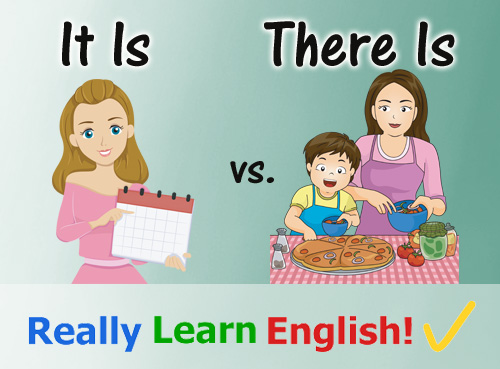It is… vs. There is…
What is the difference?
Many students have doubts about the difference between it is and there is. In reality, the two structures are not similar at all! Understanding when to use each one is very important.

Click Here for Step-by-Step Rules, Stories and Exercises to Practice All English Tenses
It is…
All sentences in English must have a subject. However, sometimes no subject is immediately apparent, or it is more convenient to use just one word. In these situations, we use the word it. It is a third person pronoun, meaning that the verb forms that accompany it are the same as the verb forms that accompany other third person pronouns (i.e., he and she).
We often use it to talk about the weather. For example, we can make sentences such "it is hot" "it is cold" and "it is raining." Even though the meaning of these sentences would be clear without it, it is not possible to leave it out. It is not possible to say "is hot" "is cold" or "is raining," because grammatically these sentences have no subject.
We also use it to talk about the time. As in the previous examples, we have to say "it is 2 o'clock," not only "is 2 o'clock." Another common use of it is to talk about people. For example, we can make sentences such as, "Who is that talking to John?" "It's his brother, Peter."
It is often accompanied by is, which is the third person conjugation of the verb "to be." The contracted form of it is is it's. However, it is important to remember that it can be followed by other verbs too. For example, we can say "it rains a lot in England" or "it often snows in winter."
Let's look at some other examples.
Examples:
- It is very hot in Mallorca in the summer.
(The weather is very hot in Mallorca, an island of Spain, in the summer.)

- "What day is it?" asked Angela.
"It's Monday," Jenny replied.
(The day is Monday.)

- "What time is the meeting?" I asked.
"I'm not sure, but I know it's in the afternoon."
(The meeting is in the afternoon.)

- "Who is that girl in the picture?"
"It's my sister, Hannah."
(The girl in the picture is my sister.)

- It's time to go to school!
(The time of day right now is the hour when we must go to school.)

There is…
When we want to say that something exists in a particular place, we use the structure there is. In there is sentences, we put the subject after the verb. Unlike with it is, there is sentences have a clear subject that we want to speak about.
For example, we can say "there is snow outside," "there is a hole in my sock" and "there is a mouse in the kitchen." We cannot say "it is snow outside," because "snow" is already the subject of the sentence. We only use it when the sentence has no subject. Similarly, we cannot say "it is a hole in my sock" or "it is a mouse in the kitchen."
In the above examples, it would be possible to say "snow is outside," "a hole is in my sock" and "a mouse is in the kitchen." However, it is more typical to use the alternate structure "there is…" because this structure emphasizes the location where the subject is located.
When we want to speak about more than one subject, we use the plural structure there are. In the past, we use the structures there was and there were, and in the future there will be or there is/are going to be. These forms also exist in the negative and interrogative: there isn't/there aren't, there won't be, there isn't going to be, etc.
Examples:
- There is an apple in the fridge.
(An apple is in the fridge.)

- There are 8 students in my class.
(Eight students are in my class.)

- There is a lot of cheese on the pizza.
(A lot of cheese is on the pizza.)

- There are going to be a lot of people at the party.
(A lot of people are going to be at the party.)

- There are a lot of candles on my birthday cake.
(A lot of candles are on the birthday cake.)

A Story to Practice It is… vs. There is…
Katie is packing her bag, because tomorrow she is going on vacation. She going to Greece, where it is very hot. It will probably be very sunny, too. In her bag, there is a bathing suit, a towel, and there are two pairs of flip flops. There isn't an umbrella and there isn't a coat, because it won't rain and it isn't cold in Greece.
Should Katie bring anything else? Hmm… at night it might be a little bit windy. There is a windbreaker in Katie's closet… maybe Katie should bring that too! At the last minute Katie also decides to bring a sweater. Now there are lots of things in Katie's bag!

Quiz
Answer the following 10 questions and then check your answers. Each question is worth 10 points.
Part 1:
- When is it is commonly used?
- To talk about the weather or the time
- To talk about people, but not the weather or time
- When there is another subject in the sentence
- To emphasize the location of a particular subject
- When do we use there is?
- To talk about the weather
- To talk about the time
- When there is no other subject in the sentence
- To emphasize the location of a particular subject
- Which sentence is written correctly?
- It is time to go to the movies.
- It is a flower on the table.
- There is 2 o'clock.
- There is snowing.
- Which of the following is written incorrectly?
- It is a beautiful, sunny day.
- It is time to eat dinner.
- There is very hot today.
- There are two pillows on the bed.
Part 2:
- ____________. I'm glad I brought my sweater.
- There are cold
- Is cold
- There is cold
- It's cold
- ____________ 5 o'clock already?
- Is it
- Is there
- Are there
- Is
- When is your birthday?
- There is March 4th.
- Is on March 4th.
- It's on March 4th.
- There are March 4th.
- Are you excited about your vacation?
- Yes, there are going to be fun!
- Yes, it's going to be really fun!
- Yes, there is going to be really fun!
- Yes, is going to be really fun!
- Are there any tissues in your bag?
- Yes, there are.
- Yes, it is.
- No, it isn't.
- No, there isn't.
- What is the weather like today?
- There is cold and a bit rainy.
- It's cold and a bit rainy.
- There are cold and rain.
- Is quite cold and rainy.
Answer Key
Part 1: 1. A | 2. D | 3. A | 4. C
Part 2: 1. D | 2. A| 3. C | 4. B | 5. A | 6. B
Get Updates, Special Offers, and English Resources
Download your FREE GIFT (the first two chapters of
English Short Stories Book and Workbook)
as soon as you join!

By submitting your email, you consent to receiving updates and newsletters from us and to the sharing of your personal data with third parties for the purposes of sending you communications. We will not spam you. You can unsubscribe at any time. For more information, please see our privacy policy.





